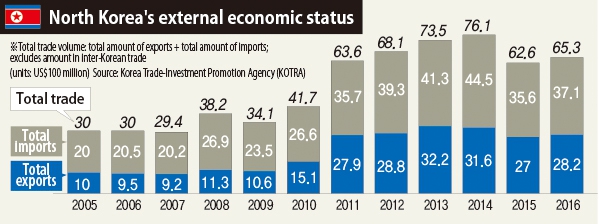 |
|
North Korea‘s external economic status
|
Vietnam-style reforms, international financial assistance and reopening of Kaesong Industrial Complex cited as three possibilities
US Secretary of State Mike Pompeo’s first mention of bold plans for “economic rewards” such as permissions of private investment in exchange for North Korean denuclearization is focusing attention on whether North Korea may take its first steps toward becoming a normal trading country after its upcoming summit with the US. With Pompeo’s suggestions assuming the lifting of international sanctions against the North and the establishment of diplomatic ties between the North and the US, a path could open up for the North Korean economy to head toward historic reforms and openness. 1. Normal trade and WTA membership: Is ‘Vietnam-style openness’ a possibility? In addition to “real economic prosperity” for North Korea, Pompeo cited the example of “[past] adversaries who we are now close partners with.” On this basis, analysts have speculated he may have envisioned something along the lines of the Vietnamese development model. North Korean leader Kim Jong-un also reportedly expressed interest in Vietnam-style reforms and openness during his recent summit with South Korean President Moon Jae-in. Following its normalization of diplomatic relations with the US in 1995, Vietnam established normal trade relations (NTR) with it through a bilateral trade agreement in 2001, in which both sides applied equal tariffs. “If you look at the Vietnamese example, normal trade relations with the US were a key step toward actively courting private capital and normalizing trade with other countries,” said Korea Institute for International Economic Policy senior research fellow Jeong Hyung-gon. In 2006, the US Congress passed a bill for permanent normal trade relations (PNTR) with Vietnam; the following year, Vietnam became a World Trade Organization (WTO) member. Even after normalizing relations with the US, it still took Vietnam 12 years to be fully admitted into international trade. Internal disagreements within Congress over the issues of human rights and cheap industrial product imports had proven difficult to mediate – suggesting a process of overcoming a political fight in Congress is essential for normalization of trade and lifting of sanctions. “With North Korea as well, there’s the potential for political issues to be a risk factor, including the one-man dictatorship and human rights issues,” Jeong said. 2. ADB financial assistance: Part of the international community? A second plan involves financial support by way of an international organization such as the Asian Development Bank (ADB) or Asian Infrastructure Investment Bank (AIIB). This kind of infrastructure investment is not merely a matter of procuring funds – it also signifies North Korea expanding economic cooperation from its past bilateral framework with South Korea to a multilateral one and participating as part of the international community. This too would require some time. To receive infrastructure investment support from an international financial organization, a country needs to be a member; only IMF members can join the World Bank, ADB, or AIIB. “It would take around three years for North Korea to be able to join the IMF,” predicted Deputy Prime Minister and Minister of Strategy and Finance Kim Dong-yeon. There is a way to obtain assistance as a non-member country. While it may not constitute infrastructure investment, the World Bank can provide technical assistance (TA) to support the formulation of a development plan with approval by its general assembly. “The key is going to be when the conditions will be in place for the countries that account for the largest share of the international organizations – the US, Japan, and the nations of Europe – to agree to financial support to North Korea,” predicted Ministry of Strategy and Finance development finance bureau director Yoon Tae-sik. 3. Kaesong Industrial Complex a KORUS FTA outward processing zone? The Kaesong Industrial Complex could also serve as a bridge linking North Korean and US trade. When South Korea and the US concluded their FTA in 2007, they agreed to establish a “Korean Peninsula outward processing zone committee” to discuss whether to recognize items produced at the complex as having been made in South Korea. Conditions for the discussions included progress on denuclearization of the Korean Peninsula, effects on inter-Korean relations, and compliance with labor and environment standards. Due to North Korea’s nuclear testing, however, the route to US exports remained closed until the complex was shut down in Feb. 2016. A denuclearization declaration by North Korea at its summit with the US would raise the possibility not only of the Kaesong Industrial Complex resuming operation but also a new market for US exports opening up. Kim Gwang-gil, an attorney who formerly headed the complex’s legal affairs team, explained, “If the Kaesong complex or other parts of North Korea are recognized as outward processing zones and a path is cleared for exports to the US, that would have the effect of greatly reducing sanctions against the North.” “Permitting trade with the US, as opposed to just lowering tariffs, would require permissions for the establishment of bank branches, which effectively means the lifting of financial sanctions,” Kim explained. By Jeong Eun-ju, Bang Jun-ho and Heo Seung, staff reporters Please direct comments or questions to [english@hani.co.kr]






